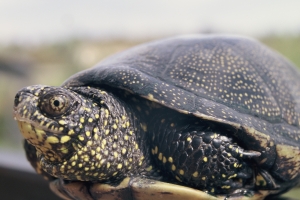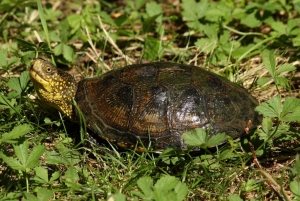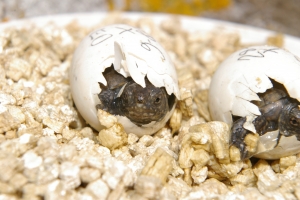ARTICLE / "The European Pond Turtle in Catalonia"
The European Pond Turtle (Emys orbicularis) is widely distributed in Europe but remains very fragmented and disparate populations. The gradual decline of this species has become very clear over the last twenty years and is now an endangered species.
As for Catalonia, was once widely distributed as evidenced by the fossil record and historical references. The modifications made in their habitats and water pollution has been a major factor regression.
Currently in our country, the number of individuals that still live in natural conditions does not exceed 500 units.
In the Ebre Delta a small pond turtle population remains comprising individuals of the Gallo-Italic population and subspecies fritzjuergenobsti from natural populations of some uncontrolled releases and introductions made before establishing the current taxonomic classification of the species.
In the region of La Selva, specifically in the area of Riudarenes, Caldes and Sils marshes, there remains a small town with individuals of the orbicularis subspecies.
In the Lower Ter the species became extinct in the nineties, but through a captive breeding program, with the last individuals of this population and thanks to the habitat recovery, it has been possible to restore back the species in the area, thanks to the LIFE program EMYS TER.
In the lake basin of Banyoles few specimens remain, like the Lower Ter River, related to the orbicularis subspecies. In recent years a recovery program through specimens born in captivity in the CRT Albera has been carrying out, as well as habitat improvement with the financing of the LIFE program.
The recovery of the lake of Ivars and Vila-sana, in the region of Urgell, has been important to introduce the species in this area of central Catalonia, in the near future allowing the establishment of a new population.
They are also some isolated specimens in some parts of the country, remains of ancient populations, as in Aiguamolls de l’Empordà, in the Pineda in Salou, the stream of Ridaura (Selva Marítima) and in rivers such as Segre, Ebre and Ter.
The captive breeding programs are conducted at the Biological Station of the Canal Vell at Delta de l’Ebre Natural Park, at the Centre de Recuperació d’Amfibis i Rèptils de Catalunya (CRARC) and at the Centre de Reproducció de Tortugues de l’Albera (CRT). The latter is managed by the l’Associació d’Amics de la Tortuga de l’Albera (ATA), part of the group of partners in the LIFE project as beneficiaries of the Potamo Fauna, with the primary responsibility of producing items intended to strengthen the small stocks of Ter river pond turtles.
LIFE Potamo Fauna actions to conserve species through the drafting of protocols for captive breeding and reinforcement of natural populations, the recovery of small wetlands on the banks of the River Ter as a habitat of the species, breeding captivity and later releases in the basin of the river Ter, control of invasive turtles and scientific monitoring of the individuals released.
Authors: Joan Budó and Enric Capalleras



















